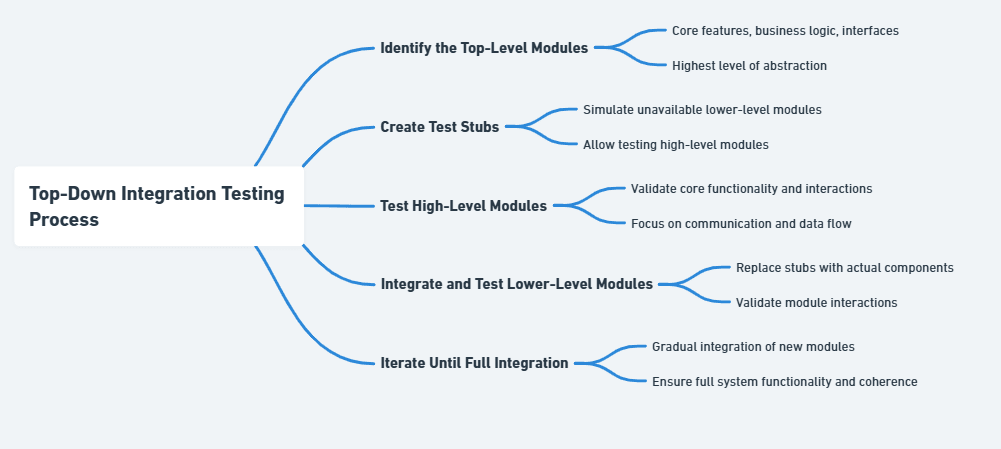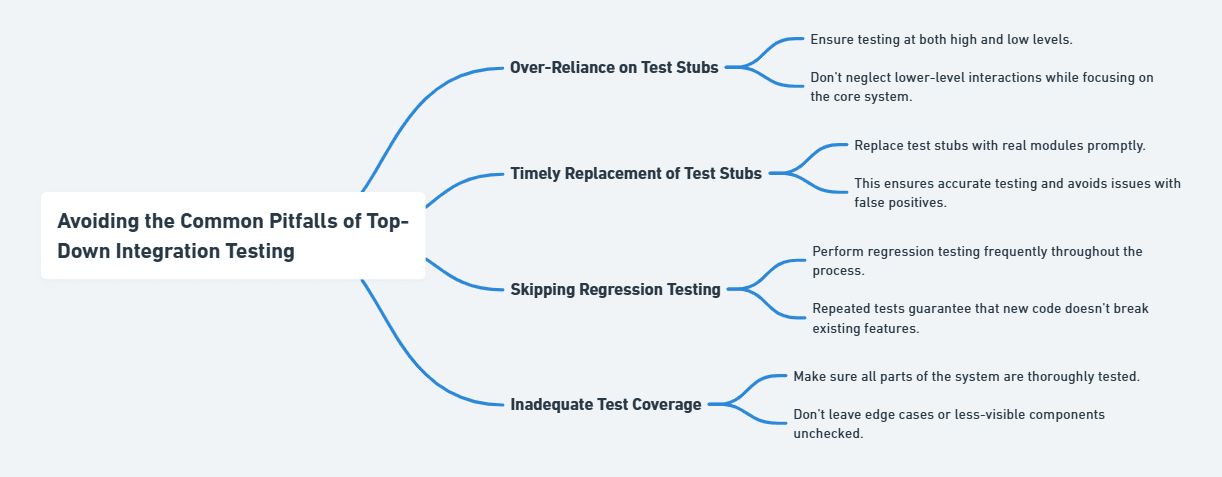Top-Down Integration Testing: What It Is, Benefits and Best Practices
In software testing, ensuring that all components of a system function correctly when integrated is critical for delivering reliable applications.

Top-down integration testing is an effective approach to achieving this. It starts with the top-level modules and progressively integrates and tests lower-level modules.
This method is especially useful when an application’s high-level components are central to its overall functionality.
This article explores top-down integration testing and its benefits and challenges, including early issue detection and reliance on test stubs. It also discusses how to effectively implement this testing strategy.
What is the Top-Down Integration Testing Approach?
Top-down integration testing is a widely used strategy in software testing. In this strategy, the process begins at the higher levels of the software system, specifically testing the core modules first. This testing approach starts with testing the most critical components, such as the user interface or primary system workflows, before progressively integrating and testing the more detailed, lower-level modules.
The diagram below highlights the structured approach of top-down integration testing, focusing on testing high-level components first, using simplified stubs to simulate unintegrated modules, and progressively testing the system to catch potential issues early.

In the early stages of testing, when certain lower-level modules are not fully developed, they are substituted with test stubs. These stubs are simplified versions of the modules that mimic their behavior.
This allows testers to focus on verifying the functionality of higher-level components without waiting for full system integration. By using this approach, the testing team can ensure that the core components of the system work as expected early on.
This can help uncover potential integration problems related to vital system workflows, especially when the functionality of the higher-level modules is crucial to the success of the system.
Once the initial high-level modules pass testing, the process gradually moves down to include the testing of lower-level components.
This approach is particularly beneficial when prioritizing core features and workflow testing before fully integrating all system parts, helping developers catch significant integration issues early.
Benefits of Top-Down Integration Testing
Top-down integration testing offers several key benefits, including early detection of critical system issues and improved debugging efficiency.
It also provides a clear focus on the most essential components of the application, contributing to a more streamlined development process.
Some key benefits that make it a popular approach are:
1. Early detection of major issues
Top-down integration testing helps catch major problems early, starting with high-level modules like user interface (UI) or core workflows. Addressing issues at this stage prevents them from affecting lower levels or the entire system.
This approach ensures critical functionality is validated before more complex issues arise, reducing the risk of costly late-stage fixes.
2. Efficient use of resources
Testing high-level modules first, which are often more complex and business-critical, ensures teams focus on the most important parts of the application. This prioritization helps teams focus on the most valuable areas, improving overall project efficiency.
3. Faster feedback for stakeholders
By testing core features early, stakeholders can quickly evaluate the functionality of key workflows. This helps gather timely feedback and facilitates collaboration.
Early testing ensures stakeholders can provide input sooner in the development cycle, allowing adjustments to be made while the project is still flexible.
4. Simplified debugging
Testing high-level modules first simplifies debugging, as issues are likely tied to interactions with the test stubs. This reduces the scope of potential problems and allows for more efficient resolution.
By identifying integration issues early, troubleshooting becomes quicker and more straightforward, minimizing disruptions in the testing process.
Challenges and Limitations
Despite its advantages, top-down integration testing has some challenges. These include the potential for incomplete testing of lower-level components and difficulties in simulating certain system behaviors without fully integrated modules.
1. Incomplete functionality
Since lower-level modules are simulated with stubs early on, they might not behave exactly like the real modules. This can lead to false positives or false negatives.
Thus, it’s crucial to ensure stubs are as accurate as possible, as any discrepancy can skew test results.
2. Complex test stubs
Creating stubs to replicate lower-level modules is time-consuming and complex. As systems grow, maintaining these stubs can divert resources away from actual development.
This complexity adds overhead to the testing process, especially when stubs need frequent updates to match evolving modules.
3. Delay in testing lower-level modules
Because testing starts with top-level modules, the lower-level ones aren’t tested until later, which can delay the discovery of integration issues.
This delay can lead to unexpected problems as the system fully integrates, especially if critical lower-level issues are uncovered too late in the process.
4. Overlooking low-level issues
Focusing first on high-level modules means that integration issues in lower-level components may go unnoticed until later. A bottom-up approach could identify these issues sooner, potentially preventing costly fixes down the road.
Top-Down Integration Testing Process
The top-down integration testing process involves systematically integrating and testing high-level modules first, then progressively incorporating lower-level modules. This ensures that each component functions correctly within the overall system.

Now that we have understood the basics, let’s look at the step-by-step process of top-down integration testing:
1. Identify the top-level modules
The first step in any top-down integration testing approach is identifying the top-level modules of your application.
These components represent the highest level of abstraction in your software system and typically involve core features, business logic, and key interfaces with external systems.
2. Create test stubs
Since the lower-level modules may not be ready for testing, developers create test stubs to simulate their behavior. A test stub is a dummy component that mimics the functionality of the actual module.
These stubs are essential for simulating the data flow and ensuring that the high-level modules interact with them as expected.
3. Test the high-level modules
With test stubs in place, testing begins at the top level. Testers focus on validating the behavior of the high-level modules, ensuring that the system’s main functions perform as expected.
During this phase, issues related to functionality, communication, and data handling can be detected and addressed.
4. Integrate and test lower-level modules
As the top-level modules are validated, lower-level modules are integrated individually. The test stubs are replaced with actual components, and additional tests are conducted to verify the proper interaction between all modules.
This process ensures that the lower-level modules are correctly integrated with the higher-level ones.
5. Iterate until full integration
The process continues iteratively, with modules being integrated and tested step by step. As each new module is added, more tests are conducted to ensure the entire system functions cohesively.
This gradual integration and testing method helps teams manage complexity and maintain control over the testing process.
Top-Down Integration Testing Examples
Let’s look at a couple of examples to better understand how top-down integration testing works in practice.
These examples showcase how this approach is applied to different software development scenarios to ensure smooth system integration.
Example 1: E-commerce platform
Focus areas:
- Start with testing the most critical user-facing features, including:
- Shopping cart
- Product catalog
- Checkout process
- These high-level modules are primary interaction points for customers.
Testing approach:
- High-level modules are tested first to ensure the core user experience (UX) works as expected.
- Test stubs are used for lower-level modules like:
- Inventory management
- Payment processing
- Shipping
- Lower-level modules might not be fully developed yet, so stubs simulate their functionality.
After initial testing:
- Once high-level modules are confirmed to function correctly, the test stubs are replaced with actual lower-level modules.
- The full system is tested end-to-end to ensure complete functionality across all components.
Example 2: Banking application
Focus areas:
- Key high-level modules for testing include:
- Customer authentication
- Account management
- Transaction processing
- These are essential for delivering primary banking services.
Testing approach:
- High-level modules are tested first to ensure they are functioning securely and efficiently.
- Test stubs are used for lower-level modules like:
- Third-party payment gateways
- Database connections (not fully integrated yet)
After initial testing:
- Once high-level modules work as expected, test stubs are replaced with the actual components.
- Full end-to-end testing is performed to ensure that transactions, account updates, and other banking functions work seamlessly and securely.
In both examples, top-down integration testing aims to verify that the most crucial components of the system function correctly before fully integrating and testing the underlying parts.
Best Practices for Top-Down Integration Testing
Best practices for top-down integration testing focus on optimizing the process by ensuring thorough testing of high-level modules first and using stubs for lower-level components.
Moreover, maintaining clear communication within the development team helps address integration issues efficiently.
To maximize the effectiveness of top-down integration testing, keep the following best practices in mind:
1. Start with clear requirements: Before beginning integration testing, it’s crucial to understand the system’s high-level modules and how they interact.
This ensures the testing process stays focused and efficient, helping to avoid confusion or unnecessary revisions.
2. Develop realistic test stubs: Since top-down testing involves using stubs for lower-level modules, ensuring these stubs closely mimic the real components is essential.
Realistic stubs will provide more accurate testing results and help identify potential integration issues early.
3. Monitor progress closely: Continuously track testing as modules are integrated. Each new integration could impact the system, so monitoring ensures that issues are identified and resolved before they become bigger problems.
4. Automate where possible: Automating tasks such as test execution or data entry can save time, reduce human error, and ensure consistency throughout the testing process.
This is especially helpful when performing repetitive tasks during integration.
5. Collaborate with developers: Working closely with developers helps testers understand the system’s architecture and design.
This collaboration allows for better identification of potential integration issues and ensures the testing process is aligned with the system’s overall goals.
Avoiding the Common Pitfalls of Top-Down Integration Testing
Avoiding common problems requires attention to key considerations that ensure the process is both effective and efficient.
By understanding potential challenges and proactively addressing them, teams can improve the overall testing outcome.

While top-down integration testing is effective, there are several pitfalls to watch out for:
1. Over-reliance on test stubs: While test stubs help simulate lower-level modules during early testing, they sometimes behave differently from the real components.
This can lead to false positives or inaccurate results. To confirm that the system functions correctly in a real-world scenario, replacing the stubs with actual modules as soon as possible is essential.
2. Delaying testing for lower-level modules: Top-down integration testing starts with high-level modules, but it’s important not to delay testing the lower-level ones.
If these modules aren’t tested sooner enough, it becomes harder to identify integration issues. Early integration of lower-level modules ensures a smoother overall testing process.
3. Skipping regression testing: As you integrate new modules, previously tested system parts may be affected. Skipping regression tests can lead to overlooked issues where new code breaks old functionality.
It’s critical to run regression tests frequently to ensure that new additions don’t compromise the integrity of the system that has already been tested.
4. Inadequate test coverage: Focusing too much on high-level modules can sometimes lead to insufficient testing of edge cases or lower-level interactions.
While it’s important to test the core features first, skipping comprehensive coverage of less visible system parts can lead to missed bugs.
Ensuring thorough test coverage at all levels, including low-level components, helps catch issues that might otherwise go unnoticed, guaranteeing the system functions as a whole.
How Can Testlio Help You with Top-Down Integration Testing
Testlio offers expert testing services that enhance software quality, helping development teams ensure reliable, high-performance applications. We provide a range of services to meet specific project needs and support efficient testing processes:
- Custom testing strategies: Tailored testing solutions to meet each project’s unique needs and goals.
- Experienced testers: Access to skilled professionals who ensure thorough, effective Top-Down Integration Testing.
- Automation integration: Seamless Continuous integration/Continuous delivery for efficient and automated testing workflows.
- Improved coverage and reliability: Comprehensive testing to enhance stability and reduce undetected bugs.
- Flexible and scalable solutions: Scalable services that adapt to your project’s evolving testing requirements.

